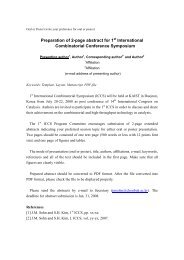Bidding - the International Association of the Catalysis Societies
Bidding - the International Association of the Catalysis Societies
Bidding - the International Association of the Catalysis Societies
You also want an ePaper? Increase the reach of your titles
YUMPU automatically turns print PDFs into web optimized ePapers that Google loves.
C&EN Volume 79, Number 44, p. 22 (October 29, 2001)<br />
Organic sheath protects silver nanowires<br />
Metal nanowires less than a nanometer thick promise to be interesting and useful tools, particularly for<br />
nanoelectronics. But such wires are so fragile and so sensi-tive to oxidation that <strong>the</strong>y tend to crumble<br />
seconds after being prepared. Now, chemistry pr<strong>of</strong>essor Kwang S. Kim, director <strong>of</strong> <strong>the</strong> Center for<br />
Superfunctional Materials at Pohang University <strong>of</strong> Science & Technology in South Korea, and his<br />
colleagues have designed a sturdy organic framework to house and protect <strong>the</strong> nanowires. Kim's group<br />
has created self-assembled nanotube clusters from calix[4]hydroquinone units [J. Am. Chem. Soc., 123,<br />
10748 (2001)]. In mixtures <strong>of</strong> acetone and water, <strong>the</strong> calix[4]hydroquinones form "chessboardlike" arrays<br />
<strong>of</strong> rectangular pores, <strong>the</strong> authors write. They insert silver ions into <strong>the</strong> tubes, creating wires no more than<br />
0.4 nm in diameter yet with micrometer-scale lengths [Science, 294, 348 (2001)]. Unlike previous<br />
attempts, which required high vacuum or extreme temperatures and pressures, <strong>the</strong> nanowire arrays can be<br />
syn<strong>the</strong>sized under mild conditions.<br />
C&EN Volume 79, Number 52 (December 24, 2001)<br />
A Better Recipe For -Fe 2 O 3 Nanocrystallites<br />
A promising new method for <strong>the</strong> syn<strong>the</strong>sis <strong>of</strong> highly crystalline, uniformly sized maghemite ( -Fe 2 O 3 )<br />
nanoparticles has been devised by researchers in South Korea [J. Am. Chem. Soc., 123, 12798 (2001)].<br />
Such magnetic nanoparticles are <strong>of</strong> interest for a host <strong>of</strong> applications, including medical imaging and<br />
drug delivery. Although relatively uniform maghemite and magnetite nanoparticles have been syn<strong>the</strong>sized<br />
recently by o<strong>the</strong>r groups, time-consuming size-selection procedures were necessary. Not so with <strong>the</strong> new<br />
method, according to Taeghwan Hyeon, an assistant pr<strong>of</strong>essor <strong>of</strong> chemical engineering at Seoul National<br />
University.<br />
Hyeon and his coworkers first prepare uniformly sized iron nanoparticles by decomposing Fe(CO) 5 in<br />
octyl e<strong>the</strong>r in <strong>the</strong> presence <strong>of</strong> oleic acid (a stabilizing agent) at 100 ºC and <strong>the</strong>n aging <strong>the</strong> iron oleate<br />
complex at 300 ºC. Next, <strong>the</strong> iron particles are oxidized to -Fe 2 O 3 nanocrystallites (shown) using<br />
trimethylamine oxide [(CH 3 ) 3 NO], a mild oxidant. By adjusting reaction parameters, <strong>the</strong> researchers can<br />
"tune" <strong>the</strong> size <strong>of</strong> <strong>the</strong> -Fe 2 O 3 particles from 4 to 16 nm. Particles 13 nm in size can also be made in a<br />
single step using a variation <strong>of</strong> <strong>the</strong> procedure. Hyeon foresees using <strong>the</strong> process to prepare multikilogram<br />
quantities <strong>of</strong> nanoparticles.<br />
Chemist Christopher B. Murray's team at IBM Watson Research Center in Yorktown Heights, N.Y., has<br />
tried <strong>the</strong> new syn<strong>the</strong>sis, and Murray says "it works beautifully." The high quality, crystallinity, and<br />
uniformity <strong>of</strong> <strong>the</strong> particles are "pretty compelling," he tells C&EN. Murray thinks <strong>the</strong> method "will be<br />
rapidly adopted as a new standard" for <strong>the</strong> preparation <strong>of</strong> -Fe 2 O 3 nanoparticles.<br />
- 74 -



